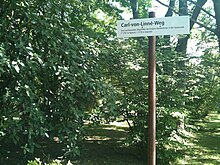Mainz Botanical Garden



The botanical garden of the Johannes Gutenberg University in Mainz was laid out between 1946 and 1955 on a site that was previously an agricultural area with fruit trees and a military training area. Today the botanical garden in the open air and in the greenhouses is home to around 8500 plant species from almost all regions of the world. The botanist Wilhelm Troll (1897–1978) was the founder and first director of the Mainz Botanical Garden . He was assisted by Max Top (1895–1986) in laying out the garden.
The garden was expanded for the first time in 1948 with the construction of the first greenhouse, further expansion stages were the acquisition of two used greenhouses (1952), the construction of the highest greenhouse to this day, the so-called connector (1954), the expansion to include a replica of the Mainz sand ( 1986, the area of the garden covers around 10 hectares since then), the redesign of the succulent house (1997) and the construction of a new tropical house (1999).
Tasks of the botanical garden
As part of the University of Mainz, the Botanical Garden is used for research and teaching as well as for the preservation of biological diversity. In addition, his tasks include public relations work and further education, trainees can complete vocational training to become gardeners ( growing ornamental plants ). The garden is available to the public for occasional cultural events and recreation. There are regular or individual guided tours through the botanical garden all year round.
Since the beginning of 2010, the "Green School", a new extracurricular learning location of the Biology Department at Johannes Gutenberg University, has been available to school classes. The educational offer is aimed at all age groups and deals with topics such as the importance of biological diversity , its conservation and sustainable use.
Head of the Botanical Garden
The directors of the Botanical Garden:
- 1946–1964 Wilhelm Troll
- 1964–1979 Hans Weber
- 1979–1981 Dimitri Hartl (acting)
- 1981–1990 Stefan Vogel
- 1990–1991 Dimitri Hartl (acting)
- since 1991 Joachim W. Kadereit
The director is supported by a technical manager and a curator .
Special shows
At irregular intervals there are special exhibitions on botanical topics such as " Plants in the Bible ", plant explorers or, as in the Darwinian year , on evolution in the plant world.
particularities
1997 already considerable large was Agave in succulents - Greenhouse planted, which could potentially date back to the early days of the Botanical Garden in the 1950s. Since no origin and age were documented, it was originally assumed that it was an Agave horrida , which, given the seven centimeters long, needle-shaped leaf tips, was a perfectly appropriate name. Over the years, however, the agave had grown so large that this determination became increasingly questionable. At the beginning of 2014 it had reached a diameter of more than two meters and began to form a powerful inflorescence. A new identification was now possible based on the characteristics of the inflorescence: It is the Mexican agave salmiana . Since the inflorescence grew between three and six centimeters per day in February 2014, it was expected that the roof of the greenhouse would be reached by the end of February. A corresponding hole and a possible frost protection were prepared. However, this was not necessary due to the mild weather and the agave only broke through the roof at the end of April 2014 and formed a first branch of the inflorescence there. On June 23, 2014 the first flower buds opened. It was the first bloom of a large agave species in the Mainz Botanical Garden since it was founded. With this event, the life cycle of the plant, which spanned several decades, is completed and it subsequently dies.
See also
Web links
- Botanical garden of the Johannes Gutenberg University Mainz
- Green school in the botanical garden
- Plants - Research - Preservation: 60 years of the Mainz Botanical Garden
Individual evidence
- ↑ Botanical Garden Mainz: History. Johannes Gutenberg University Mainz, accessed on February 24, 2020 .
- ↑ Ralf Omlor, Joachim W. Kadereit: 60 Years of the Botanical Garden - Theme Year 2007. Johannes Gutenberg University Mainz, accessed on February 24, 2020 .
- ↑ Botanical Garden Mainz: Tasks. Johannes Gutenberg University Mainz, accessed on February 24, 2020 .
- ↑ Botanical Garden Mainz: Green School. Johannes Gutenberg University Mainz, accessed on February 24, 2020 .
- ^ City of Mainz: Green School in the Botanical Garden of Johannes Gutenberg University Mainz. Retrieved February 24, 2020 .
- ↑ Botanical Garden Mainz: garden management . Johannes Gutenberg University Mainz, accessed on February 24, 2020 .
- ↑ Botanical Garden Mainz: Exhibitions and annual themes. Johannes Gutenberg University Mainz, accessed on February 24, 2020 .
- ↑ Ralf Omlor: Object of the Month - February 2014: Maguey de pulque - The large agave in the Botanical Garden. Johannes Gutenberg University Mainz, accessed on February 24, 2020 .
- ↑ Ralf Omlor: Maguey de Pulque - Agave salmiana Otto ex Salm-Dyck. Johannes Gutenberg University Mainz, accessed on February 24, 2020 .
Coordinates: 49 ° 59 ′ 32.28 " N , 8 ° 14 ′ 37.28" E

